OPERATION CRUSADER TO LIFT AXIS SIEGE OF TOBRUK
Tobruk, Cyrenaica, Eastern Libya • November 18, 1941
On this date in 1941 the British Eighth Army, an assortment of British, Commonwealth, Indian, and other Allied servicemen commanded by Lt. Gen. Alan Cunningham (from November 26 by Lt. Gen. Neil Ritchie), launched a surprise military operation from Egyptian territory against Axis forces in Eastern Libya (Cyrenaica). Operation Crusader, part of the wider Western Desert Campaign in North Africa (June 1940 to February 1943), had as its goal lifting the siege of Tobruk, put in place by the Axis on April 10, 1941. Tobruk was an important Libyan Mediterranean supply port for whoever held it. At the moment it was still in the hands of the British 70th Infantry Division, a stubborn contingent of largely British, Australians, and Poles, after German and Italian forces under German Gen. Erwin Rommel, commander of Panzergruppe Afrika, which included the German Afrika Korps and the Italian XXI Corps, had expelled most of the British Eighth Army from Libya in Operation Sunflower (Unternehmen Sonnenblume, February to May 1941).
The 20-day effort to break the Axis siege of Tobruk centered on the Eighth Army capturing the little dirt airstrip at Sidi Rezegh, a forward airbase for the Axis that lay only a dozen or so miles/around 19 km south of the seaport town. By the end of the second day of fighting at the airstrip, burning hulks of aircraft and tanks, mixed with pulverized dust, limited visibility, shrouding hundreds of dead and dying that littered the airstrip. But the airstrip was in British hands, though not for long. On November 22, 1941, the Germans launched a 3‑pronged attack on British forces holding the airfield. The result was the slaughter of British tanks and men at little cost to the Germans. A measure of revenge was attained the next day by British armor mauling German tanks, 72 in the attack that day. Though the British had lost over 300 tanks around Sidi Rezegh in 3 days, the Eighth Army was able to replace much of its armor from reserves just over the border in Egypt. The Germans, over a thousand miles/over 1,600 km of roads east of their resupply bases in Western Libya, were unable to do the same.
Meanwhile, the 2nd New Zealand Division, advancing on Sidi Rezegh from the north with 133 heavy Matilda and Valentine tanks, attacked the Germans and Italians holding the airfield late on November 25. A part of the division linked up with the encircled Tobruk garrison the next day and briefly kept the corridor open. Within a few days 130 replacement vehicles from Egypt replenished the stocks of the British 7th Armored Division taking up positions south of Sidi Rezegh. Against heavy odds Axis forces retook the much-contested airfield because Rommel had embraced the combined-arms doctrine while British field commanders failed to coordinate armor with infantry to increase the effectiveness of their combat formations defending Sidi Rezegh. By this time, however, the enemy was a spent force. Rommel could muster just 38 operational tanks, while the British brought up their tank strength by several hundred. Just as bad, Rommel was down to his last containers of fuel and boxes of ammunition. Attrition rather than bad generalship finally forced the Desert Fox on December 7, 1941, to withdraw his forces 40 miles/64 km east to Gazala and abandon the siege of Tobruk. Operation Crusader was the first Allied victory over German land forces in World War II.
Operation Crusader: Lifting the Axis Siege of Tobruk, November 18 to December 7, 1941
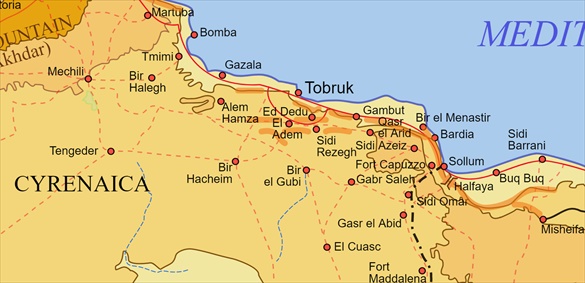 |
Above: The 241-day Siege of Tobruk, the small but key Mediterranean supply port in Cyrenaica (Eastern Italian Libya), began on April 10, 1941. This was midway into the German and Italian advance through Eastern Libya in Operation Sunflower (February 6 to May 25, 1941), the 12‑week pursuit of Egyptian-based British forces in Libya during the Western Desert Campaign (1940–1943). In little more than half a year of the British Eighth Army’s lifting the Axis siege of Tobruk on December 7, 1941, Field Marshal Erwin Rommel’s Panzerarmee Afrika retook Tobruk in mid-July 1942. The seaport remained in Axis hands until November 13, 1942, after the British Eighth Army under Gen. Bernard Law Montgomery bested Axis forces in Egypt at the Second Battle of El Alamein (October 23 to November 11, 1942).
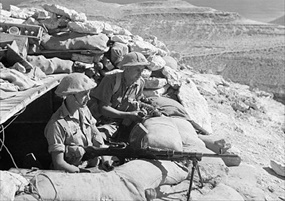 | 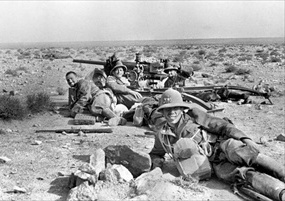 |
Left: Manning a Bren light machine gun near Tobruk, November 10, 1941, are men of the 2nd Battalion, Leicestershire Regiment, part of the British 70th Infantry Division. By the 25th of the previous month, British replacements for the evacuated Australian 9th Infantry Division garrison brought in 34,113 service members and added 126 tanks to the garrison’s armor strength. All together the British Eighth Army had 738 tanks, the majority of which were A.15 Crusader tanks, followed by the Matilda infantry tank.
![]()
Right: Famous German field marshal Erwin Rommel took thousands of striking wartime photographs prior to his suicide in 1944. Rommel toted a camera while commanding frontline troops in France and North Africa, wielding a lens with artistic flare and precision. In this photograph Italian soldiers smile for Rommel’s camera in North Africa sometime in 1941. The men were members of 1 of 3 Italian infantry divisions that, along with Rommel’s Afrika Korps, invested Tobruk for 8 months in 1941.
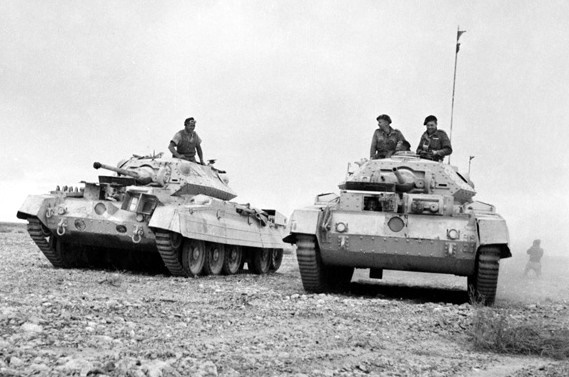 | 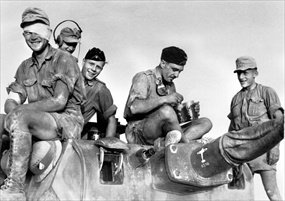 |
Left: Armor spearheaded the effort to reach the British garrison besieged at the Libyan port of Tobruk. In this photo a pair of British Crusader tanks takes up position at the forefront of their formation as 2 commanders confer during Operation Crusader. When Operation Crusader was launched, the Crusader tank was the frontline tank of British armored units everywhere in North Africa.
![]()
Right: Soldiers of the Afrika Korps pose for Rommel atop a tank, circa 1941. Rommel photographed many scenes from soldiers’ everyday lives on the front lines. Unlike photos taken by Wehrmacht photographers, Rommel’s photos of his men were candid and unpolished. Rommel had an eye for drama and was drawn to taking larger-than-life images of machines, tanks, and vehicles. He liked to photograph people in the midst of activity; rarely are his human subjects idle or completely at leisure. Soldiers are usually working, pausing a moment for rest as in this scene, or traveling. With few exceptions he took no photos of soldiers lounging, playing cards, or horsing around; it appears Rommel had little interest in leisurely pastimes but was predominantly concerned with his work or that of his men.
Allied and Axis Operations in North Africa: Silent Color Footage from British and German Archives
![]()

 History buffs, there is good news! The Daily Chronicles of World War II is now available as an ebook for $4.99 on Amazon.com. Containing a year’s worth of dated entries from this website, the ebook brings the story of this tumultuous era to life in a compelling, authoritative, and succinct manner. Featuring inventive navigation aids, the ebook enables readers to instantly move forward or backward by month and date to different dated entries. Simple and elegant! Click
History buffs, there is good news! The Daily Chronicles of World War II is now available as an ebook for $4.99 on Amazon.com. Containing a year’s worth of dated entries from this website, the ebook brings the story of this tumultuous era to life in a compelling, authoritative, and succinct manner. Featuring inventive navigation aids, the ebook enables readers to instantly move forward or backward by month and date to different dated entries. Simple and elegant! Click 











